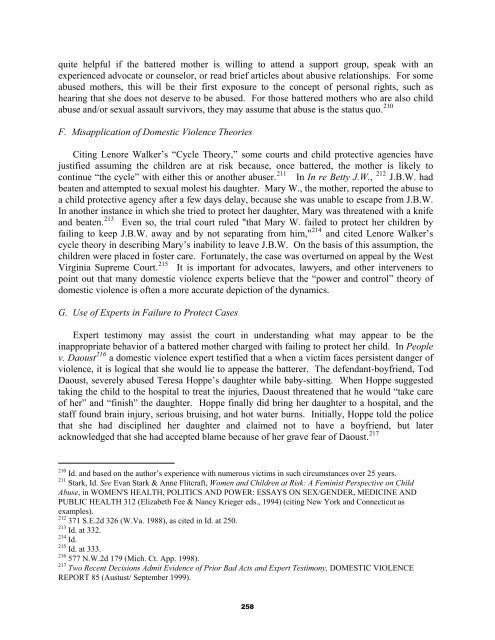A Judge’s Guide
A Judge’s Guide
A Judge’s Guide
Create successful ePaper yourself
Turn your PDF publications into a flip-book with our unique Google optimized e-Paper software.
quite helpful if the battered mother is willing to attend a support group, speak with an<br />
experienced advocate or counselor, or read brief articles about abusive relationships. For some<br />
abused mothers, this will be their first exposure to the concept of personal rights, such as<br />
hearing that she does not deserve to be abused. For those battered mothers who are also child<br />
abuse and/or sexual assault survivors, they may assume that abuse is the status quo. 210<br />
F. Misapplication of Domestic Violence Theories<br />
Citing Lenore Walker’s “Cycle Theory,” some courts and child protective agencies have<br />
justified assuming the children are at risk because, once battered, the mother is likely to<br />
continue “the cycle” with either this or another abuser. 211 In In re Betty J.W., 212 J.B.W. had<br />
beaten and attempted to sexual molest his daughter. Mary W., the mother, reported the abuse to<br />
a child protective agency after a few days delay, because she was unable to escape from J.B.W.<br />
In another instance in which she tried to protect her daughter, Mary was threatened with a knife<br />
and beaten. 213 Even so, the trial court ruled "that Mary W. failed to protect her children by<br />
failing to keep J.B.W. away and by not separating from him," 214 and cited Lenore Walker’s<br />
cycle theory in describing Mary’s inability to leave J.B.W. On the basis of this assumption, the<br />
children were placed in foster care. Fortunately, the case was overturned on appeal by the West<br />
Virginia Supreme Court. 215 It is important for advocates, lawyers, and other interveners to<br />
point out that many domestic violence experts believe that the “power and control” theory of<br />
domestic violence is often a more accurate depiction of the dynamics.<br />
G. Use of Experts in Failure to Protect Cases<br />
Expert testimony may assist the court in understanding what may appear to be the<br />
inappropriate behavior of a battered mother charged with failing to protect her child. In People<br />
v. Daoust 216 a domestic violence expert testified that a when a victim faces persistent danger of<br />
violence, it is logical that she would lie to appease the batterer. The defendant-boyfriend, Tod<br />
Daoust, severely abused Teresa Hoppe’s daughter while baby-sitting. When Hoppe suggested<br />
taking the child to the hospital to treat the injuries, Daoust threatened that he would “take care<br />
of her” and “finish” the daughter. Hoppe finally did bring her daughter to a hospital, and the<br />
staff found brain injury, serious bruising, and hot water burns. Initially, Hoppe told the police<br />
that she had disciplined her daughter and claimed not to have a boyfriend, but later<br />
acknowledged that she had accepted blame because of her grave fear of Daoust. 217<br />
210<br />
Id. and based on the author’s experience with numerous victims in such circumstances over 25 years.<br />
211<br />
Stark, Id. See Evan Stark & Anne Flitcraft, Women and Children at Risk: A Feminist Perspective on Child<br />
Abuse, in WOMEN'S HEALTH, POLITICS AND POWER: ESSAYS ON SEX/GENDER, MEDICINE AND<br />
PUBLIC HEALTH 312 (Elizabeth Fee & Nancy Krieger eds., 1994) (citing New York and Connecticut as<br />
examples).<br />
212<br />
371 S.E.2d 326 (W.Va. 1988), as cited in Id. at 250.<br />
213<br />
Id. at 332.<br />
214<br />
Id.<br />
215<br />
Id. at 333.<br />
216<br />
577 N.W.2d 179 (Mich. Ct. App. 1998).<br />
217<br />
Two Recent Decisions Admit Evidence of Prior Bad Acts and Expert Testimony, DOMESTIC VIOLENCE<br />
REPORT 85 (Austust/ September 1999).<br />
258


